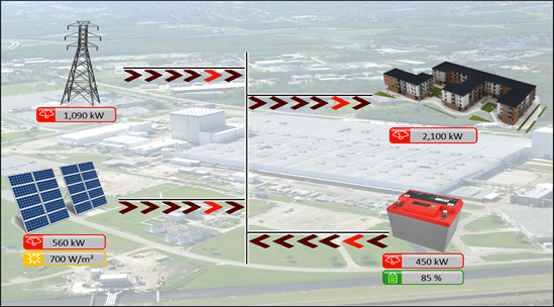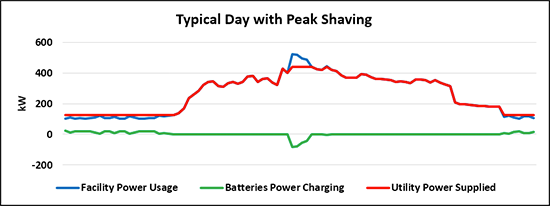

S S Energy Technologies peak shaving solution utilizes battery storage to reduce your peak demand and lower your electric bill. The system monitors the facility load in real-time and automatically draws power from the batteries as needed to keep the demand below a set level. Batteries can be charged from the utility grid during off-peak times to reduce cost or directly from a renewable source such as solar or wind. Each system is designed to maximize return on investment based on the facility demand and the electric rate schedule.
 Batteries can react to power needs quickly with no ramp up or cool down required like a typical generator.
Batteries can react to power needs quickly with no ramp up or cool down required like a typical generator.
 No EPA limitations on battery usage for demand response and peak shaving. Emergency generators are limited to 15 hours per year.
No EPA limitations on battery usage for demand response and peak shaving. Emergency generators are limited to 15 hours per year.
 Different battery chemistries available (Lithium Ion, Aqueous Hybrid Ion, Lead Acid, Nickel–zinc, Vanadium-flow) depending on installation location and discharge rate needed.
Different battery chemistries available (Lithium Ion, Aqueous Hybrid Ion, Lead Acid, Nickel–zinc, Vanadium-flow) depending on installation location and discharge rate needed.
 Very little user interaction or maintenance required.
Very little user interaction or maintenance required.

 Shows status of all the power sources.
Shows status of all the power sources.
 Battery charge/discharge rate is displayed along with power flow throughout the system.
Battery charge/discharge rate is displayed along with power flow throughout the system.
 Records historical data to show energy usage and savings.
Records historical data to show energy usage and savings.
A typical electric rate schedule for an industrial or commercial facility includes both consumption and demand charges. Consumption is the amount of energy that is used for the billing period. This is what most people expect to pay for in their electrical bill. The other significant charge is demand. Demand represents the peak power usage for the billing period. Utilities include this charge to pass on the cost of the infrastructure required to deliver power. This cost can be as much as 30 to 50 percent of the electric bill.
Lowering the power usage from the utility during those peak times is called peak shaving and it can significantly reduce your electric bill. This can be done by either reducing the power being consumed in the facility, such as shutting down a production line, or by offsetting the usage with another source of power such as batteries. The batteries are charged when power usage is low and discharged during the peaks. A typical day for a facility using this system is displayed below.

In this example the facility has a peak power usage in the middle of the day for one hour. The batteries automatically discharge during that time at a rate that keeps the utility power usage below 440 kW to avoid setting a new peak and incurring additional cost. Charging of the batteries is done during the evening and early morning when power usage for the facility is low in order to minimize the cost.